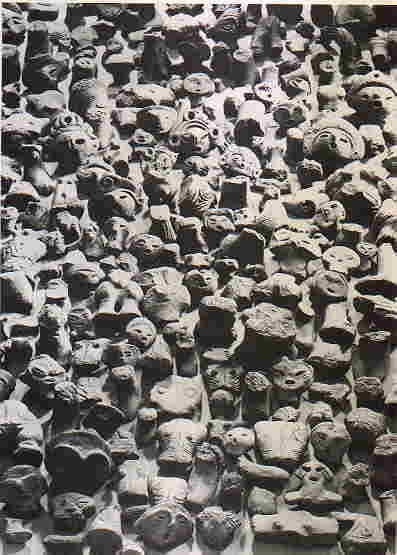
Different from the earthenware made in the same period, clay dolls have seldom been found whole and complete. All dolls, except in extremely rare cases, were excavated in fragments. Furthermore, they can be seldom restored to their complete figures with the fragments found in the same place. For example, as many as 1,116 fragments of clay dolls, a seventh of all the clay dolls so far found in Japan, were excavated in the Shakado Site in Yamanashi Prefecture, but there was not a single whole and complete one among them, and no perfect doll was reconstructed with those innumerable fragments. Among 1,116 pieces, there were 22 cases in which a piece could be put together with another piece. But even in these cases, one piece was found at 120 meters' distance of the other one, and the longest distance between two matching pieces was 230 meters.
This leads archaeologists to assume that in the mid-Jomon Period, people took a lot of trouble to make elaborate clay dolls, and then destroyed them and took the pieces to different places. Furthermore, it is clear that Jomon people who lived in the Shakado Site made the dolls with the purpose of destroying them. They first made parts of dollsf body with separate masses of clay, and tied the parts together with strings made of tree or bamboo. This devise enabled them to easily gbreakh dolls into neat pieces.
Fragments of dolls worshipped in the house
After the mid-Jomon Period, people not only
broke clay dolls but carefully enshrined
and worshipped their fragments in the house. In the Tochikura Site in Tochio City, Niigata
Prefecture, for example, it was confirmed
that fragments of a clay doll was treated
as a deity in one of the three houses which
belong to the mid-Jomon Period.
There is a circular hole of 26 cm in diameter
and 51 cm in depth in the house. The hole is filled with black mud and pieces
of charcoal mixed. In the center of the hole, a clay dollfs
body part without its head, arms and legs
is put upside down. Fragments of earthenware whose inside are
painted red are pressed against the wall
of the hole, and surround the broken doll.
The body of the clay doll is propped up with
pieces of another earthenware so that it
does not fall down.
In another place of the house, an oblong
stone is placed. It is about 23 cm long and
7 cm high. Its upper surface is polished, and its side
has yellow paint remaining. On this stone, which is supposed to be an altar, a broken clay doll without
its head and lower half of the body is lying on its back.
Why
did Jomon people make a clay doll, break
it and worship its fragments?
A
theory says that Jomon people broke the part
of a clay doll corresponding to their ill
part, and pray to a god for recovery. But
a professor at Gakushuin University, Atsuhiko
Yoshida, proposes a more convincing theory
in his Mysteries of Jomon Religion (Tokyo: Yamato Shobo, 1993), connecting the doll-breaking and -worshipping
act with an Indonesian myth which used to be told among a native tribe,
the Wemales in Ceram, one of the Moluccas
Islands.
Broken clay dolls and Goddess Hainuwele
The heroine of the Indonesian myth, Goddess
Hainuwele, was born on a coconut tree in
the same way as a coconut grows. The owner of the tree, Ameta, saw her, brought
her down and raised her as his daughter. She grew up into a beautiful girl in no time. When she discharged solid wastes out of her
body, they marvelously came out as valuable
goods. Ameta soon became a wealthy man.
At one time, over many nights, Hainuwele
kept giving away treasures she discharged
to people who were dancing around her through
the night. She was boundlessly generous. People who received treasures finally found
her behavior wierd, and during the dance
on the last night they threw her down into
a deep hole they had dug beforehand. They threw earth in on her, danced on it,
tread down to harden it and buried her alive.
Next day Ameta knew what had happened, and
dug up his daughterfs dead body, and cut
it into many pieces. He took the pieces to different places and
buried them. Then a different kind of potato grew up from
each piece. The myth concludes that thanks to this, human
beings can grow those potatoes in their fields
and live on them.
The same type of myth is told widely from
Indonesia, through Melanesia and Polynesia
to South America and a part of North America.
Professor
Yoshida says that Japan has the same myth
and that it is told as early as in Kojiki (AD 712) which collected stories and tells
the history of the royal family at that time,
starting from the age of gods. He thinks
the myth has the same origin of the Hainuwelemyth, which is most likely to have already
arrived at Japan on its way to Melanesia,
Polynesia and other countiries in the Jomon Period.
His theory is that Jomon clay dolls were
a goddess of Hainuwele, and those broken
fragments were parts of the goddess's body
from which potatoes and other foods would
grow. Jomon people prayed to a goddess of
fertility as all races and tribes did and
do.
Back to Top page
Next Page